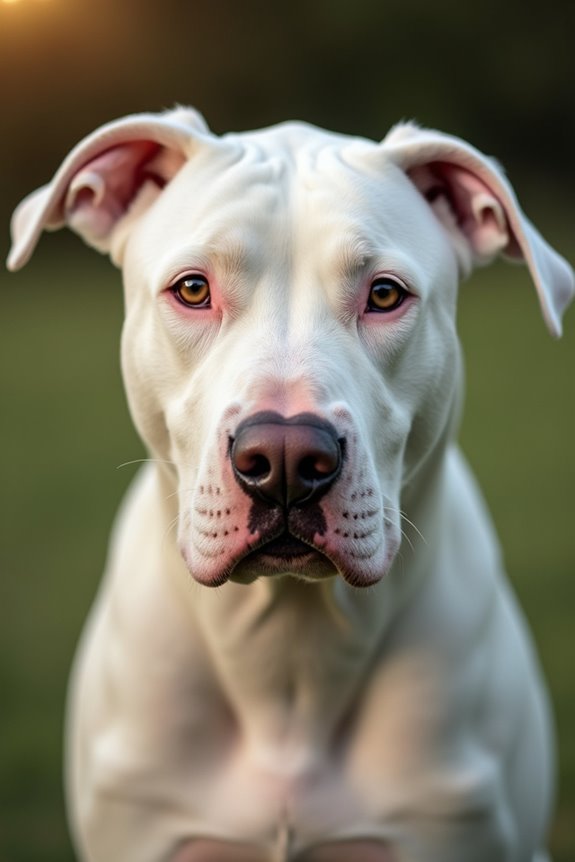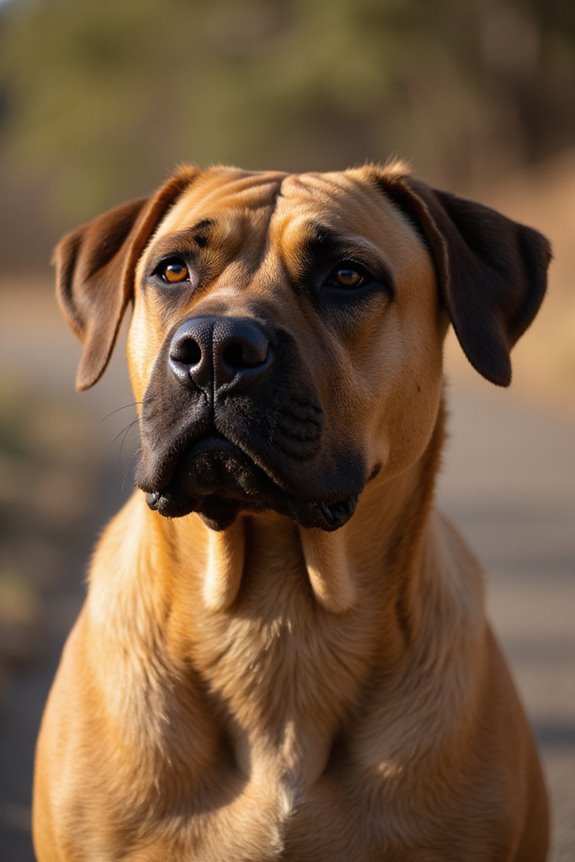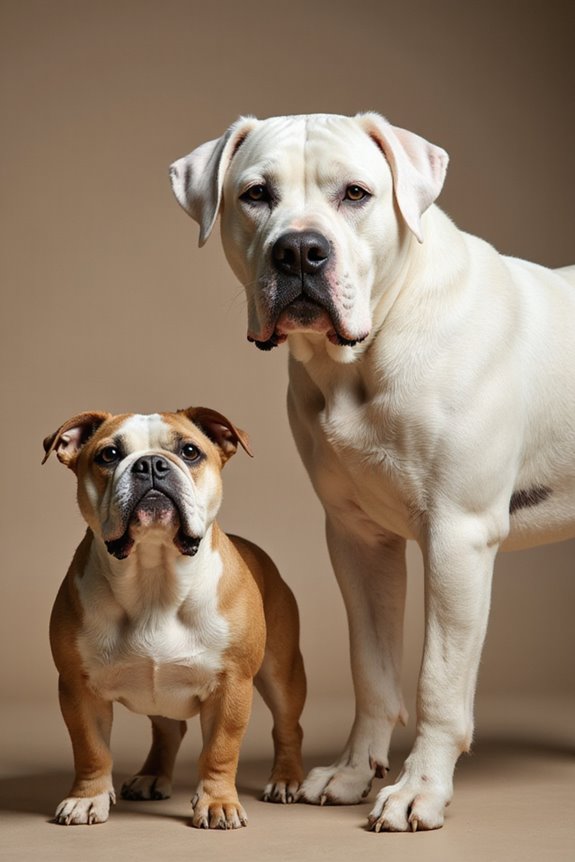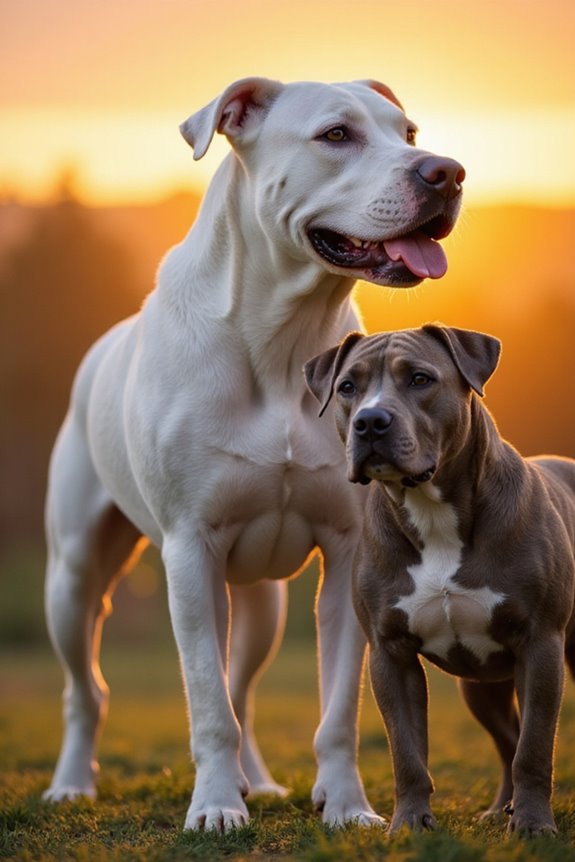When comparing the Dogo Argentino and Bull Terrier regarding strength, I find several key differences. The Dogo Argentino, larger and muscular, boasts a bite force of approximately 500 PSI, ideal for hunting. In contrast, the Bull Terrier, known for agility, has a bite force under 300 PSI. They both require substantial exercise, at least one to two hours daily, to manage their high energy. For a deeper understanding of their unique traits and care recommendations, consider further exploration.
Key Takeaways
- The Dogo Argentino has a superior bite force of approximately 500 PSI, making it stronger than the Bull Terrier’s under 300 PSI.
- Dogo Argentinos are larger and more muscular, enhancing their overall strength and endurance compared to the stockier Bull Terrier.
- Both breeds require proper training to effectively manage their strength and prevent behavioral issues related to aggression.
- The Dogo Argentino’s specialized jaw anatomy allows for powerful and focused bites, particularly beneficial in hunting scenarios.
- Bull Terriers excel in agility and stamina, relying on their energetic nature rather than sheer strength like the Dogo Argentino.
Physical Size and Build
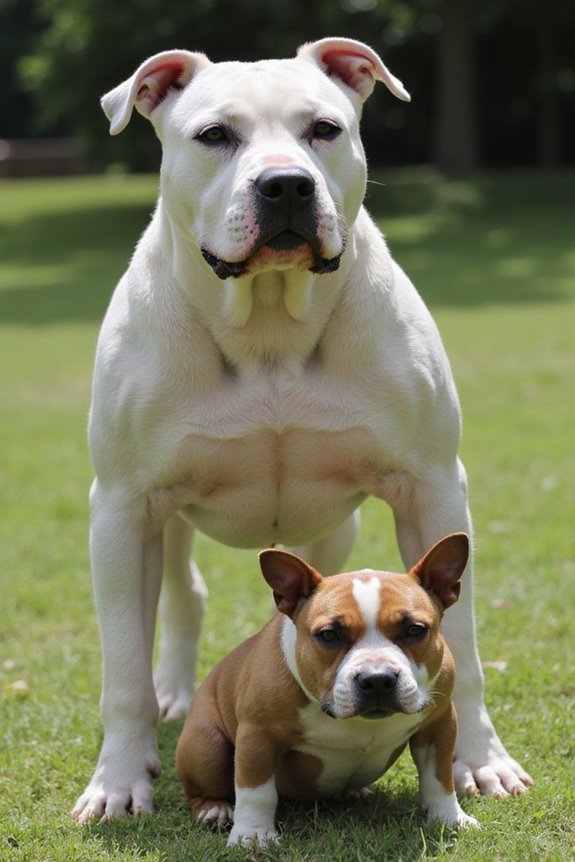
When comparing the physical size and build of the Dogo Argentino and the Bull Terrier, it is essential to take into account several key characteristics that differentiate these breeds. The Dogo Argentino typically stands between 24-30 inches tall and weighs 75-110 pounds, boasting significant muscle endurance and a robust frame designed for hunting. Conversely, the Bull Terrier ranges from 18-21 inches and weighs about 45-65 pounds, exhibiting a stocky build with compact body proportions.
Key differences include:
- Height Advantage: The Dogo’s larger stature allows for greater reach and leverage in activities.
- Muscle Endurance: The Dogo’s athletic build supports prolonged physical exertion, while the Bull Terrier excels in agility.
- Body Proportions: The Dogo’s frame emphasizes power and strength compared to the Bull Terrier’s compact strength.
Bite Force and Jaw Strength
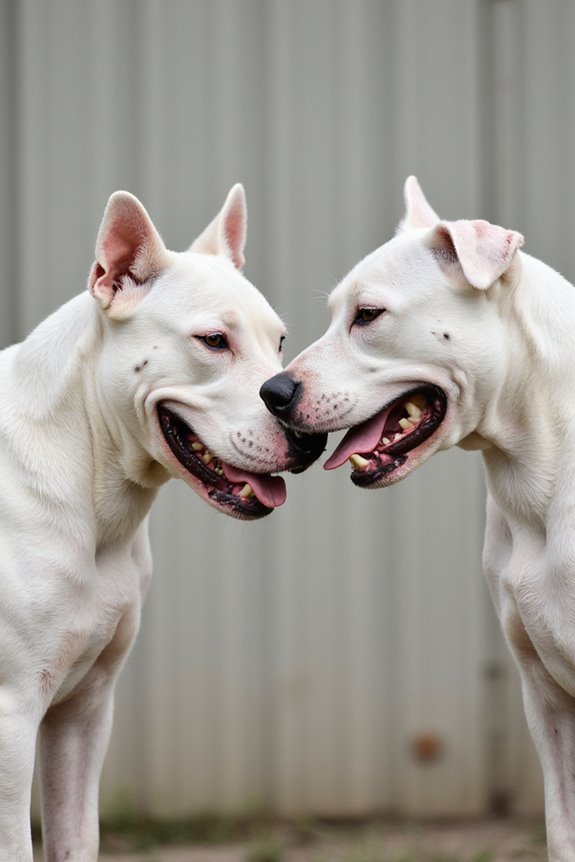
The bite force and jaw strength of a dog are critical factors that contribute greatly to its functional abilities and behavioral traits. The Dogo Argentino’s impressive bite force of approximately 500 PSI stems from its robust jaw anatomy, specifically designed for gripping and holding large prey. This powerful jaw allows for crushing bites focused on smaller surface areas, crucial during hunting. In contrast, the Bull Terrier exhibits a bite force generally under 300 PSI, more suited for companionship and agility than raw power.
- Dogo Argentino:
- Bite Force: 500 PSI
- Jaw Anatomy: Muscular and specialized for hunting.
- Bull Terrier:
- Bite Force: Under 300 PSI
- Jaw Anatomy: Strong yet less specialized for hunting tasks.
Understanding these intricacies in bite mechanics is essential for dog ownership and training.
Energy Levels and Exercise Needs
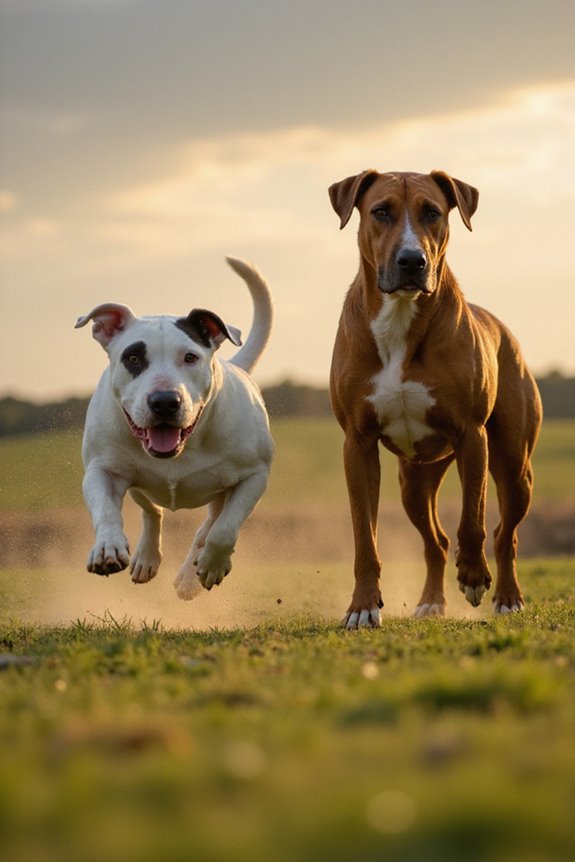
Understanding the energy levels and exercise needs of both the Dogo Argentino and Bull Terrier is vital for responsible ownership and training. Both breeds are high-energy and require significant physical activity.
- Dogo Argentinos need at least one to two hours of exercise daily, ideally off-leash in secure spaces.
- Bull Terriers require similar, often exceeding two hours to match their activity levels.
Both breeds thrive on diverse activities to manage their exercise intensity and energy expenditure effectively. Insufficient exercise can lead to behavioral issues, including destructiveness.
To support their needs, a fenced area is highly recommended, allowing them the freedom to expend their energy safely and enjoyably. Regular physical and mental stimulation is essential for their overall well-being.
Temperament and Aggression Control
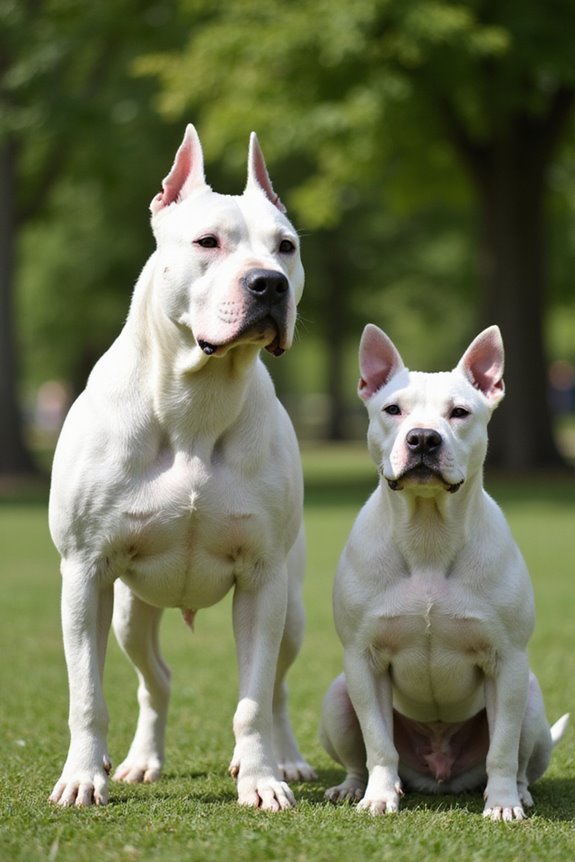
Temperament and aggression control are critical aspects of owning both the Dogo Argentino and Bull Terrier, especially since these breeds possess strong personalities that can lead to behavioral challenges if not managed properly.
- Dogo Argentino: Known for their courageous and protective temperament traits, they require early and consistent socialization to help manage their territorial aggression towards strangers.
- Bull Terrier: Their affectionate nature makes them great family companions, but they are prone to jealousy and neediness. Strong impulse control is essential to manage their stubbornness and prevent behavioral issues.
Both breeds need experienced owners committed to aggression management, focusing on proper training and social interaction to channel their instincts positively. With dedication, you can create a well-adjusted environment for your beloved pet.
Diet and Weight Management
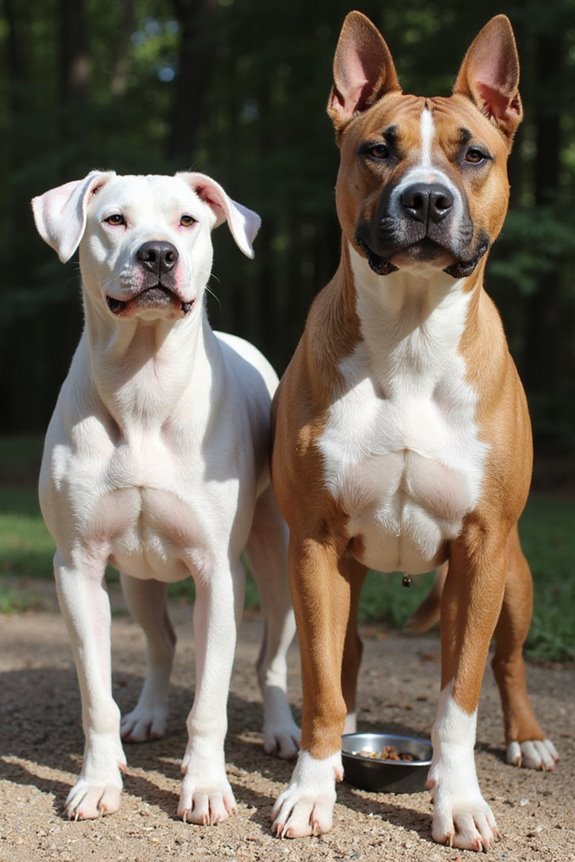
Diet and weight management play vital roles in maintaining the health and well-being of both Dogo Argentinos and Bull Terriers. Each breed has distinct nutritional requirements that must be met for ideal health.
- Dogo Argentinos: Typically need 6 to 8 cups of high-quality dry food daily, focusing on high-quality animal-based proteins to sustain their larger size and muscle mass.
- Bull Terriers: Generally consume 2.5 to 3.5 cups daily and need careful portion control due to a higher risk of obesity.
Adopting proper feeding practices, like dividing meals into two daily servings, supports digestion and prevents issues like gastric dilatation. Regular veterinary consultations are essential for personalizing diets, ensuring each dog maintains a healthy weight throughout its life.
Speed and Agility
When evaluating the speed and agility of the Dogo Argentino and the Bull Terrier, it’s vital to take into account their respective physiological traits and breeding backgrounds. The Dogo Argentino, built for hunting, boasts a maximum speed of around 25 MPH, making them exceptionally suited for endurance. In contrast, Bull Terriers, reaching about 18 MPH, are more recreationally agile and thrive in familiar indoor environments.
When it comes to training, both breeds require specific approaches:
- Dogo Argentino: Needs rigorous speed training and agility exercises, such as long-distance running and obstacle courses.
- Bull Terrier: Requires less intense training, focusing on fun, shorter sessions that emphasize obedience and indoor agility.
Adapting training to their strengths is essential for peak performance.
Hunting and Working Abilities
In the domain of hunting and working abilities, understanding the specific roles and traits of both the Dogo Argentino and the Bull Terrier is essential for potential owners and trainers. The Dogo Argentino was bred for big-game hunting, emphasizing endurance and power with excellent hunting instincts. Their muscular build and higher bite force make them effective in tracking and pursuing large prey like wild boars and pumas. In contrast, Bull Terriers, originally bred for bull-baiting, lack these specialized hunting capabilities. While they exhibit determination and agility, their working roles are less defined. For those looking for a dedicated hunter, the Dogo Argentino is clearly more suitable, while the Bull Terrier is better suited as a lively companion.
Lifespan and Health Considerations
Understanding the lifespan and health considerations of both the Dogo Argentino and Bull Terrier is essential for prospective owners who want to guarantee the well-being of their pets. The Dogo Argentino typically lives between 9-15 years, while the Bull Terrier averages 10-14 years. Health management plays a critical role in their longevity factors, including dietary choices and preventive care.
Common Health Issues:
- Dogo Argentino: Prone to hip dysplasia, deafness, dental issues, and other systemic diseases.
- Bull Terrier: Susceptible to kidney disease, skin allergies, and heart conditions.
Both breeds require regular veterinary check-ups and proactive health management strategies, like dental care and controlled diets, to enhance their lifespan and maintain quality of life.
Conclusion on Strength Differences
While evaluating the differences in strength between the Dogo Argentino and the Bull Terrier, it becomes evident that their physical attributes and historical backgrounds significantly influence their capabilities. The Dogo Argentino, with its larger size and significant muscle mass, boasts a stronger bite force of 250 to 300 PSI, ideal for hunting. In comparison, the Bull Terrier’s smaller frame and reduced jaw strength highlight its breed characteristics focused more on agility.
Training methods also differ; the Dogo’s endurance allows for sustained strength training, whereas the Bull Terrier’s compact build relies on short bursts of energy. Understanding these distinctions not only informs prospective owners but also emphasizes the importance of proper conditioning in nurturing each breed’s innate strengths.
Frequently Asked Questions
Are Dogo Argentinos More Suitable as Family Pets Than Bull Terriers?
I think Bull Terriers suit family dynamics better than Dogo Argentinos, honestly. Their temperament traits make them friendlier and more adaptable around kids and visitors, while Dogo Argentinos can be more protective and reserved.
How Do Dogo Argentinos and Bull Terriers Compare in Training Ease?
I get that training can feel overwhelming, but with proper techniques and consistent behavior, both breeds respond well. Dogo Argentinos need more patience, while Bull Terriers thrive on fun. It’s all about connection and understanding!
What Grooming Needs Do Dogo Argentinos and Bull Terriers Have?
I find grooming both breeds pretty straightforward. Dogo Argentinos need weekly brushing for their coats, while Bull Terriers also benefit from regular care. Both require occasional baths, which helps maintain their unique coat types and overall health.
Can Dogo Argentinos and Bull Terriers Thrive in Apartments?
I understand the worry about space requirements and noise levels when considering a Dogo Argentino or Bull Terrier in an apartment. Honestly, they thrive better with room to run, feel free to explore their potential!
Are Dogo Argentinos and Bull Terriers Prone to Specific Health Issues?
I’ve noticed that both Dogo Argentinos and Bull Terriers can face specific health challenges, like genetic disorders and common ailments. Regular vet visits and care can really help keep our furry friends healthy and happy.

